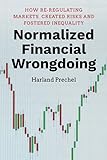Normalized financial wrongdoing : how re-regulating markets created risks and fostered inequality / Harland Prechel.
By: Prechel, Harland [author.]
Publisher: Stanford, California : Stanford University Press, 2021Description: xvi, 362 pages ; 24 cmContent type: text Media type: computer Carrier type: online resourceISBN: 9781503602380; 9781503614451Subject(s): Financialization -- United States | Corporations -- Government policy -- United States | Corporation law -- United States | Corporations -- Corrupt practices -- United States | Income distribution -- United StatesGenre/Form: Electronic books.Additional physical formats: Online version:: Normalized financial wrongdoing.DDC classification: 332/.04150973 LOC classification: HG181 | .P74 2021Online resources: Full text available at Ebscohost Click here to view| Item type | Current location | Home library | Call number | Status | Date due | Barcode | Item holds |
|---|---|---|---|---|---|---|---|
 EBOOK
EBOOK
|
COLLEGE LIBRARY | COLLEGE LIBRARY | 332/.04150973 (Browse shelf) | Available |
Includes bibliographical references (pages 313-336) and index.
The contemporary corporation and private property -- Historical transitions from liberalism to neoliberalism -- Transforming banks from market enablers to market participants -- Converging economic and political interests -- Creating risk, engaging in financial malfeasance, and crisis -- A "great crisis" in the FIRE sector -- The extent and causes of financial malfeasance -- Inequality in the twenty-first century -- A unified upper class, the fractured middle and working classes, and the potential for emancipatory social change.
In Normalized Financial Wrongdoing, Harland Prechel examines how social structural arrangements that extended corporate property rights and increased managerial control opened the door for misconduct and, ultimately, the 2008 financial crisis. Beginning his analysis with the financialization of the home-mortgage market in the 1930s, Prechel shows how pervasive these arrangements had become by the end of the century, when the bank and energy sectors developed political strategies to participate in financial markets. His account adopts a multilevel approach that considers the political and legal landscapes in which corporations are embedded to answer two questions: how did banks and financial firms transition from being providers of capital to financial market actors? Second, how did new organizational structures cause market participants to engage in high-risk activities? After careful historical analysis, Prechel examines how organizational and political-legal arrangements contribute to current record-high income and wealth inequality, and considers societal preconditions for change. Provided by publisher.

There are no comments for this item.